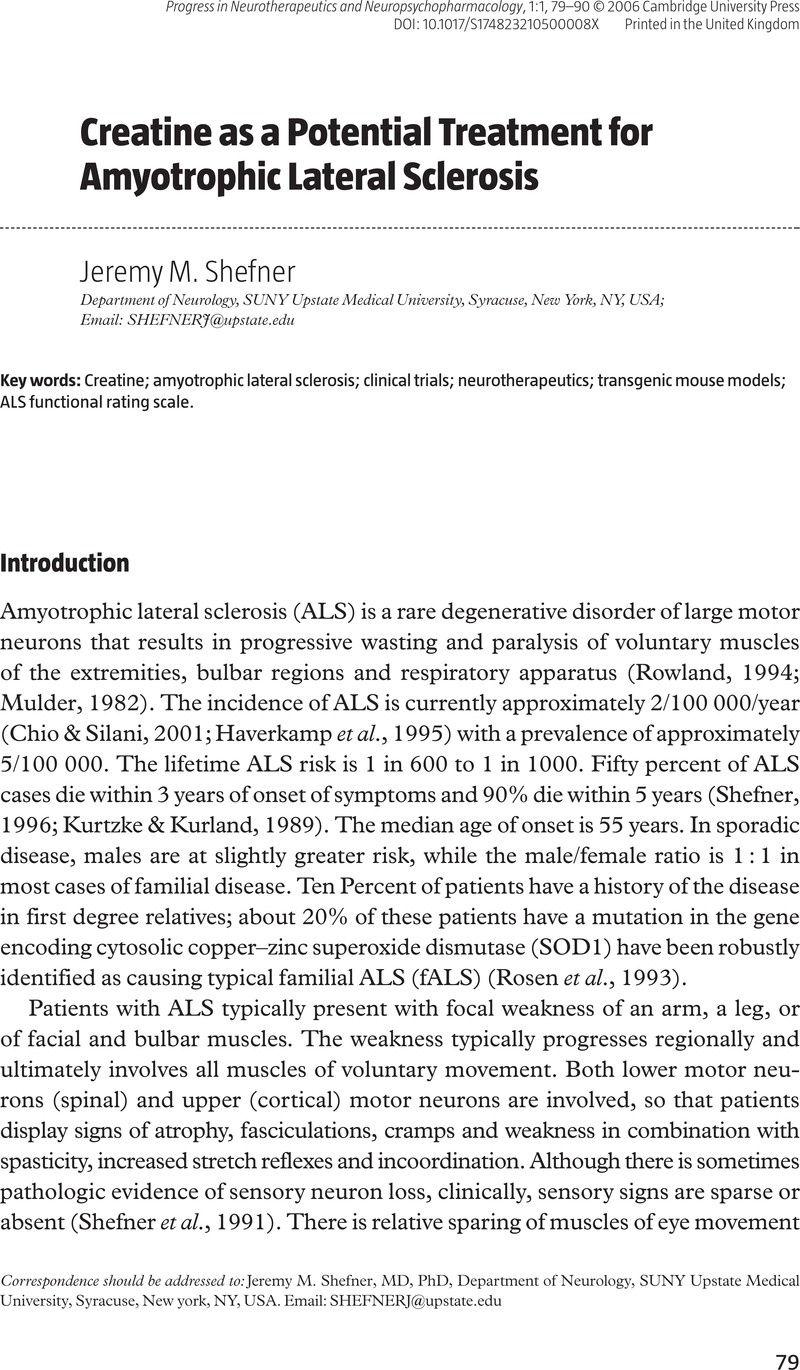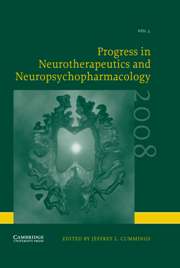No CrossRef data available.
Article contents
Creatine as a Potential Treatment for Amyotrophic Lateral Sclerosis
Published online by Cambridge University Press: 15 February 2006
Abstract
An abstract is not available for this content so a preview has been provided. Please use the Get access link above for information on how to access this content.

Keywords
- Type
- Review Article
- Information
- Progress in Neurotherapeutics and Neuropsychopharmacology , Volume 1 , Issue 1 , January 2006 , pp. 79 - 90
- Copyright
- © 2006 Cambridge University Press
References
Andreassen, O.A., Dedeoglu, A., Klivenyi, P., Beal, M.F., et al. (2000). N-acetyl-l-cysteine improves survival and preserves motor performance in an animal model of familial amyotrophic lateral sclerosis [In Process Citation]. NeuroReport, 11, 2491–2493.Google Scholar
Bensimon, G., Lacomblez, L., & Meininger, V. (1994). A controlled trial of riluzole in amyotrophic lateral sclerosis. New England Journal of Medicine, 330, 585–591.Google Scholar
Beutner, G., Ruck, A., Riede, B., & Brdiczka, D. (1998). Complexes between porin, hexokinase, mitochondrial creatine kinase and adenylate translocator display properties of the permeability transition pore. Implication for regulation of permeability transition by the kinases. Biochimica Et Biophysica Acta, 1368, 7–18.Google Scholar
Brooks, B. (1994). El Escorial World Federation of Neurology criteria for the diagnosis of amyotrophic lateral scerosis. Subcommittee on Motor Neuron Diseases/Amyotrophic Lateral Sclerosis of the World Federation of Neurology Research Group on Neuromuscular Diseases and the El Escorial Clinical limits of amyotrophic lateral sclerosis. Journal of the Neurological Sciences, 124 (Suppl), 96–107.Google Scholar
Brown, W.F., Strong, M.J., & Snow, R. (1988). Methods for estimating numbers of motor units in biceps–brachialis muscles and losses of motor units with aging. Muscle Nerve, 11, 423–432.Google Scholar
Bruijn, L.I., Beal, M.F., Becher, M.W., Schulz, J.B., et al. (1997). Elevated free nitrotyrosine levels, but not protein-bound nitrotyrosine or hydroxyl radicals, throughout amyotrophic lateral sclerosis (ALS)-like disease implicate tyrosine nitration as an aberrant in vivo property of one familial ALS-linked superoxide dismutase 1 mutant. Proceedings of the National Academy of Sciences, USA, 94, 7606–7611.Google Scholar
Carter, G.T., Krivickas, L.S., Weydt, P., Weiss, M.D., et al. (2003). Drug therapy for amyotrophic lateral sclerosis: Where are we now?. Idrugs, 6, 147–153.Google Scholar
Cedarbaum, J.M., Stambler, N., Malta, E., Fuller, C., et al. (1999). The ALSFRS-R: a revised ALS functional rating scale that incorporates assessments of respiratory function. BDNF ALS Study Group (Phase III). Journal of the Neurological Sciences, 169, 13–21.Google Scholar
Chio, A., Silani, V. (2001). Amyotrophic lateral sclerosis care in Italy: a nationwide study in neurological centers. Journal of Neurological Sciences, 191, 145–150.Google Scholar
Cudkowicz, M.E., Shefner, J.M., Schoenfeld, D.A., Brown, Jr., R.H., et al. (2003). A randomized, placebo-controlled trial of topiramate in amyotrophic lateral sclerosis. Neurology, 61, 456–464.Google Scholar
Dal Canto, M.C. (1995). Comparison of pathological alterations in ALS and a murine transgenic model: pathogenetic implications. Clinical Neuroscience, 3, 332–337.Google Scholar
Drachman, D.B., Frank, K., Dykes-Hoberg, M., Teismann, P., et al. (2002). Cyclooxygenase 2 inhibition protects motor neurons and prolongs survival in a transgenic mouse model of ALS. Annals of Neurology, 52, 771–778.Google Scholar
Eisen, A., & Weber, M. (1999). Treatment of amyotrophic lateral sclerosis. Drugs Aging, 14, 173–196.Google Scholar
Ferrante, R.J., Browne, S.E., Shinobu, L.A., Bowling, A.C., et al. (1997). Evidence of increased oxidative damage in both sporadic and familial amyotrophic lateral sclerosis. Journal of Neurochemistry, 69, 2064–2074.Google Scholar
Gredal, O., Werdelin, L., Bak, S., Christensen, P.B., et al. (1997). A clinical trial of dextromethorphan in amyotrophic lateral sclerosis. Acta Neurologica Scandinavia, 96, 8–13.Google Scholar
Groeneveld, G.J., Veldink, J.H., van der Tweel, I., Kalmijn, S., et al. (2003). A randomized sequential trial of creatine in amyotrophic lateral sclerosis. Annals of Neurology, 53, 437–445.Google Scholar
Group A-CTS. (1996). A double-blind placebo-controlled clinical trial of subcutaneous recombinant human ciliary neurotophic factor (rHCNTF) in amyotrophic lateral sclerosis. Neurology, 46, 1244–1249.Google Scholar
Gubbay, S.S., Kahana, E., Zilber, N., Cooper, G., et al. (1985). Amyotrophic lateral sclerosis. A study of its presentation and prognosis. Journal of Neurology, 232, 295–300.Google Scholar
Gurney, M.E., Cutting, F.B., Zhai, P., Doble, A., et al. (1996). Benefit of vitamin E, riluzole and gabapentin in a transgenic model of familial amyotrophic lateral sclerosis [see comments]. Annals of Neurology, 39, 147–157.Google Scholar
Gurney, M.E., Fleck, T.J., Himes, C.S., & Hall, E.D. (1998). Riluzole preserves motor function in a transgenic model of familial amyotrophic lateral sclerosis. Neurology, 50, 62–66.Google Scholar
Haverkamp, L.J., Appel, V., & Appel, S.H. (1995). Natural history of amyotrophic lateral sclerosis in a database population. Validation of a scoring system and a model for survival prediction. Brain, 118 (Pt 3), 707–719.Google Scholar
Hemmer, W., & Wallimann, T. (1993). Functional aspects of creatine kinase in brain. Developmental Neuroscience, 15, 249–260.Google Scholar
Hirano, A. (1991). Cytopathology in amyotrophic lateral sclerosis. Advanced Neurology, 56, 91–101.Google Scholar
Jablecki, C.K., Berry, C., & Leach, J. (1989). Survival prediction in amyotrophic lateral sclerosis. Muscle Nerve, 12, 833–841.Google Scholar
Julien, J.P., Couillard-Despres, S., & Meier, J. (1998). Transgenic mice in the study of ALS: the role of neurofilaments. Brain Pathology, 8, 759–769.Google Scholar
Julien, J.P., & Mushynski, W.E. (1998). Neurofilaments in health and disease. Progress in Nucleic Acid Research and Molecular Biology, 61, 1–23.Google Scholar
Klivenyi, P., Ferrante, R.J., Matthews, R.T., Bogdanov, M.B., et al. (1999). Neuroprotective effects of creatine in a transgenic animal model of amyotrophic lateral sclerosis. Natural Medicine, 5, 347–350.Google Scholar
Klivenyi, P., Kiaei, M., Gardian, G., Calingasan, N.Y., et al. (2004). Additive neuroprotective effects of creatine and cyclooxygenase 2 inhibitors in a transgenic mouse model of amyotrophic lateral sclerosis. Journal of Neurochemistry, 88, 576–582.Google Scholar
Kong, J., & Xu, Z. (1998). Massive mitochondrial degeneration in motor neurons triggers the onset of amyotrophic lateral sclerosis in mice expressing a mutant SOD1. Journal of Neurosciences, 18, 3241–3250.Google Scholar
Kurtzke, J. (1989). Risk factors in amyotrophic lateral sclerosis. Advanced Neurology, 56, 245–270.Google Scholar
Kurtzke, J., & Kurland, L. (1989). The epidemiology of neurologic disease. In: Joynt, R. (ed.), Clinical Neurology, Philadelphia, PA: Lippincott, pp. 1–43.
Lacomblez, L., Bensimon, G., Leigh, P., Guillett, P., et al. (1996). Dose-ranging study of riluzole in amyotrophic lateral sclerosis. Lancet, 347, 1428–1431.Google Scholar
Lai, E.C., Felice, K.J., Festoff, B.W., Gawel, M.J., et al. (1997). Effect of recombinant human insulin-like growth factor-I on progression of ALS. A placebo-controlled study. The North America ALS/IGF-I Study Group. Neurology, 49, 1621–1630.Google Scholar
Masui, Y., Mozai, T., & Kakehi, K. (1985). Functional and morphometric study of the liver in motor neuron disease. Journal of Neurology, 232, 15–19.Google Scholar
Miller, R.G., Moore, D.H., Gelinas, D.F., Dronsky, V., et al. (2001). Phase III randomized trial of gabapentin in patients with amyotrophic lateral sclerosis. Neurology, 56, 843–848.Google Scholar
Miller, R.G., Petajan, J.H., Bryan, W.W., Armon, C., et al. (1996). A placebo-controlled trial of recombinant human ciliary neurotrophic (rhCNTF) factor in amyotrophic lateral sclerosis. rhCNTF ALS Study Group. Annals of Neurology, 39, 256–260.Google Scholar
Mulder, D. (1982). Clinical Limits of Amyotrophic Lateral Sclerosis. In: Rowland, L.P. (ed.), Human Motor Neuron Diseases, New York: Raven Press, pp. 15–22.
Nakano, K., Hirayama, K., & Terai, K. (1987). Hepatic ultrastructural changes and liver dysfunction in amyotrophic lateral sclerosis. Archieves Neurology, 44, 103–106.Google Scholar
Ro, L.S., Lai, S.L., Chen, C.M., & Chen, S.T. (2003). Deleted 4977-bp mitochondrial DNA mutation is associated with sporadic amyotrophic lateral sclerosis: a hospital based case–control study. Muscle Nerve, 28, 737–743.Google Scholar
Robberecht, W. (2000). Oxidative stress in amyotrophic lateral sclerosis. Journal of Neurology, 247 (Suppl 1), I1–I6.Google Scholar
Rosen, D., Siddique, T., Patterson, D., Figlewicz, D., et al. (1993). Mutations in Cu/Zn superoxide dismutase gene are associated with familial amyotrophic lateral sclerosis. Nature, 362, 59–62.Google Scholar
Rothstein, J.D. (1996). Excitotoxicity hypothesis. Neurology, 47, S19–S25; discussion S26.Google Scholar
Rothstein, J.D., Dykes-Hoberg, M., Pardo, C.A., Bristol, L.A., et al. (1996). Knockout of glutamate transporters reveals a major role for astroglial transport in excitotoxicity and clearance of glutamate. Neuron, 16, 675–686.Google Scholar
Rothstein, J.D., Patel, S., Regan, M.R., Haenggeli, C., et al. (2005). Beta-lactam antibiotics offer neuroprotection by increasing glutamate transporter expression. Nature, 433, 73–77.Google Scholar
Rouleau, G.A., Clark, A.W., Rooke, K., Pramatarova, A., et al. (1996). SOD1 mutation is associated with accumulation of neurofilaments in amyotrophic lateral sclerosis. Annals of Neurology, 39, 128–131.Google Scholar
Rowland, L.P. (1994). Amyotrophic lateral sclerosis. Current Opinion in Neurology, 7, 310–315.Google Scholar
Sasaki, S., & Iwata, M. (1999). Ultrastructural change of synapses of Betz cells in patients with amyotrophic lateral sclerosis. Neuroscience Letters, 268, 29–32.Google Scholar
Schiefer, J., Landwehrmeyer, G.B., Luesse, H.G., Sprunken, A., et al. (2002). Riluzole prolongs survival time and alters nuclear inclusion formation in a transgenic mouse model of Huntington's disease. Movement Disorders, 17, 748–757.Google Scholar
Schinder, A., Olson, E., Spitzer, N., & Montal, M. (1996). Mitochondrial dysfunction is a primary event in glutamate neurotoxicity. Journal of Neurosciences, 16, 6125–6133.Google Scholar
Shefner, J.M. (1996). Amyotrophic lateral sclerosis. In: Samuels, M.A., & Feske, S. (eds.). Office Practice of Neurology, New York: Churchill Living Stone, pp. 474–479.
Shefner, J.M., Tyler, H.R., & Krarup, C. (1991). Abnormalities in the sensory action potential in patients with amyotrophic lateral sclerosis. Muscle Nerve, 14, 1242–1246.Google Scholar
Snow, R.J., Turnbull, J., da Silva, S., Jiang, F., et al. (2003). Creatine supplementation and riluzole treatment provide similar beneficial effects in copper, zinc superoxide dismutase (G93A) transgenic mice. Neuroscience, 119, 661–667.Google Scholar
Traynor, B., Zhang, H., Shefner, J., Schoenfeld, D., et al. (2004). Functional outcome measures as clinical trial endpoints in Amyotrophic Lateral Sclerosis. Neurology, 63, 1933–1935.Google Scholar
Trotti, D., Rolfs, A., Danbolt, N.C., Brown, Jr., R.H., et al. (1999). SOD1 mutants linked to amyotrophic lateral sclerosis selectively inactivate a glial glutamate transporter [published erratum appears in Natural Neurosciences, 2(9), 848]. Natural Neurosciences, 2, 427–433.Google Scholar
White, R., & Reynolds, I. (1996). Mitochondrial depolarization in glutamate-stimulated neurons: an early signal specific to excitotoxin exposure. Journal of Neurosciences, 16, 5688–5697.Google Scholar
Wong, P.C., Pardo, C.A., Borchelt, D.R., Lee, M.K., et al. (1995). An adverse property of a familial ALS-linked SOD1 mutation causes motor neuron disease characterized by vacuolar degeneration of mitochondria. Neuron, 14, 1105–1116.Google Scholar
Zhang, W., Narayanan, M., & Friedlander, R.M. (2003). Additive neuroprotective effects of minocycline with creatine in a mouse model of ALS. Annals of Neurology, 53, 267–270.Google Scholar




